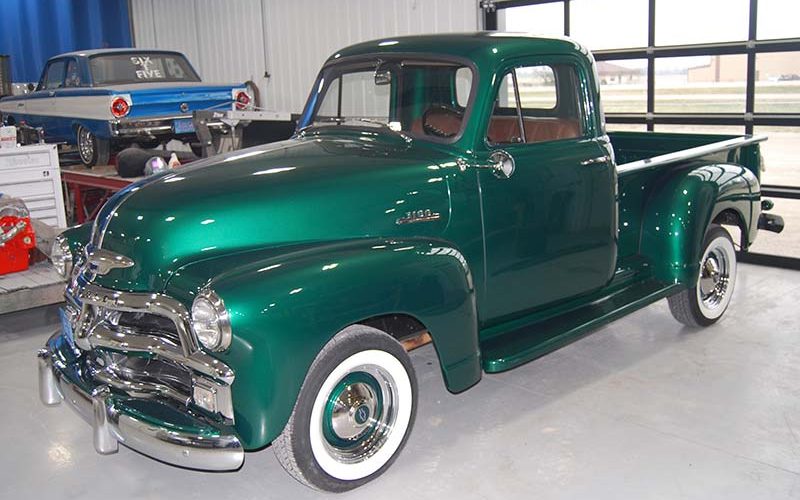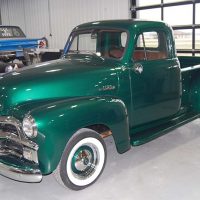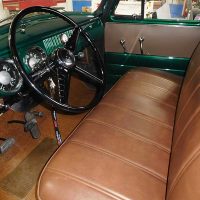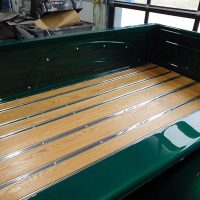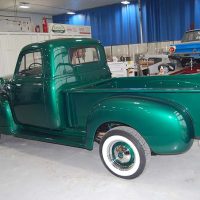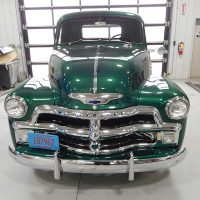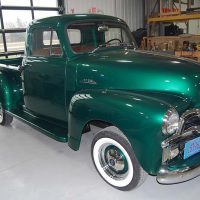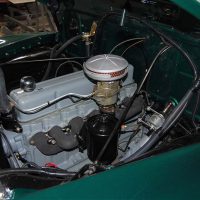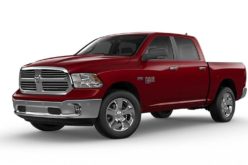Overhauled Chevy half-ton hauler
By John Gunnell
Greg’s Speed Shop LLC of Waupaca, Wis., just completed the overhaul of this
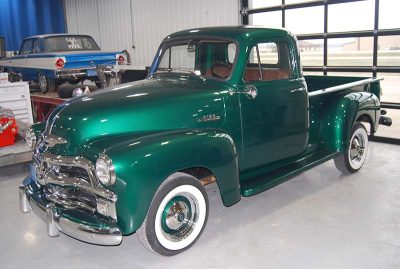
Greg’s Speed Shop restored every nut and bolt on this pickup.
half-ton Chevy hauler. The owner wanted the “family heirloom” to look new again, but we think it looks even better than when it was sitting in a Chevy showroom in 1949.
Chevy’s post World War II Advance-Design trucks had actually entered production on May 1, 1947. They were wider, lower and longer than previous models. Among major changes was an “alligator jaw” hood that was hinged at the cowl. A modern touch was integral headlights. Five horizontal bars, bowed in their centres, formed the grille.
That grille housed rectangular parking lamps between the outer ends of the top two bars. A turret-top cab was used and a desirable option was “Nu-Vue” rear corner cab windows that improved rearward vision. A larger two-piece windshield was used. Inside the cab there was a 56-inch wide bench seat covered in leatherette material.
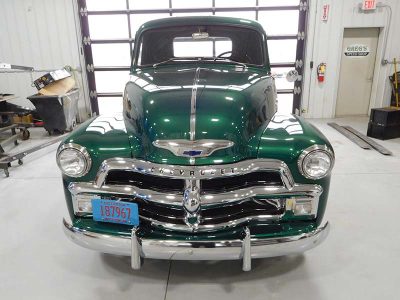
Cross-bar grille was a new-for-1954 feature.
The pickup truck cargo box or dispatch box consisted of side assemblies and an end gate. The Advance-Design box was two inches wider than that of previous Chevrolet trucks. Only one overhead-valve six-cylinder engine was used in the trucks. The standard transmission was a three-speed manual gearbox with the shifter on the steering column.
By model year 1949, the Advance-Design trucks were out long enough to start making changes of a substantial nature. The overall appearance and mechanical make up were largely the same, but the changes were the most dramatic yet seen in the series.
The cabs were now flexibly mounted to the frame at four points, which had a pentagon shape when seen from above. The method of retaining door weatherstripping changed. Grooved retainers, spot welded along the front, top and rear of the openings, were used in combination with a doorsill weatherstrip held by retainers and screws.
A change in the engine was provision for pressure lubrication of the timing gears via an oil passage from the front camshaft bearing. There was also new 14mm AC spark plugs. The Carter carburetor used in 1949 had a slightly different accelerator pump arrangement. On 1949 models only, the carburetor inner choke lever also incorporated a pin that engaged a slot in the fast-idle linkage to control choke valve operation and prevent unnecessary flooding. There were slight changes in the 1949 steering column gearshift mechanism. A 17-1//2-US gallon fuel tank was located behind the seat.

The interior trim is a work of art.
This was the first year that chrome series designation plates appeared on the sides of the hood on Advance-Design trucks. The ½-ton trucks carried the designation “3100.” The serial number is located on a plate attached to the rear face of the left-hand door hinge pillar and on the right side of the cowl under the hood. A typical number is 21GP-C 4192. The first or first two symbol(s) indicate the assembly plant 21=Janesville, Wis. The next two symbols indicate the model prefix/series: GP=3100 ½-ton series. The next symbol indicates the month of production: C=third month (March 1949). The next series of digits is the sequential production number which started with 1001 at each factory.
The pickup was designated the 3104 model and sold for just $1,263. Yes, there was a time when pickups were the cheapest thing on the lot. The half-tonner tipped the scales at 3,185 lbs. The Chevy “Stovebolt Six” was an in-line engine with overhead valves and a cast iron block. Bore and stroke were 3.50 x 3.75 inches for a 216.5-cid displacement. The compression ratio was 6.6:1. The motor made 90 hp at 3,300 rpm and developed 174 pounds-feet of torque at 1,200-2,000 rpm. It had four main bearings, mechanical valve lifters and a Carter downdraft one-barrel model W1-574S.
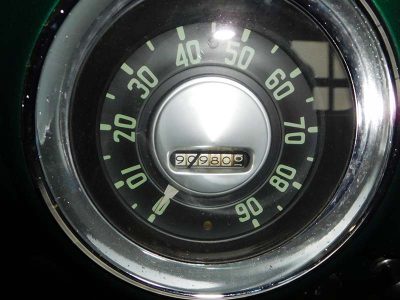
The truck has 90,980 original miles, but few miles on engine rebuild.
Other Advance-Design Chevy features included a 116-inch wheelbase, 196.6-inch overall length, a 4200 lbs./4500 lbs./ 4600 lbs. GVW rating and 6.00 x 16 tires. Greg’s restored the truck with 15-inch “gangster whitewall” tires to slightly streamline its looks. The truck has a three-speed manual gearbox with column-mounted shifter. Chrome bumpers are mounted on it front and rear. It also has dual chrome outside rearview mirrors and the factory’s Deluxe chrome trim package.
Greg’s Speed Shop stressed safety features such as period-correct directional signals (which weren’t standard equipment in 1949), dual taillights and chrome bumper guards on each end of the truck. Period-correct dispatch box wood side rails are fitted. According to the 2020 Collector Car Price Guide by AIM Publications, a ’49 pickup in perfect shape like this one is worth approximately $40,000 today. That makes the original price quite a good investment. The truck has appreciated over 3,000 percent!




